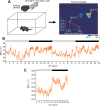Thermographic imaging of mouse across circadian time reveals body surface temperature elevation associated with non-locomotor body movements
- PMID: 34048467
- PMCID: PMC8162700
- DOI: 10.1371/journal.pone.0252447
Thermographic imaging of mouse across circadian time reveals body surface temperature elevation associated with non-locomotor body movements
Abstract
Circadian clocks orchestrate multiple different physiological rhythms in a well-synchronized manner. However, how these separate rhythms are interconnected is not exactly understood. Here, we developed a method that allows for the real-time simultaneous measurement of locomotor activity and body temperature of mice using infrared video camera imaging. As expected from the literature, temporal profiles of body temperature and locomotor activity were positively correlated with each other. Basically, body temperatures were high when animals were in locomotion. However, interestingly, increases in body temperature were not always associated with the appearance of locomotor activity. Video imaging revealed that mice exhibit non-locomotor activities such as grooming and postural adjustments, which alone induce considerable elevation of body temperature. Noticeably, non-locomotor movements always preceded the initiation of locomotor activity. Nevertheless, non-locomotor movements were not always accompanied by locomotor movements, suggesting that non-locomotor movements provide a mechanism of thermoregulation independent of locomotor activity. In addition, in the current study, we also report the development of a machine learning-based recording method for the detection of circadian feeding and drinking behaviors of mice. Our data illustrate the potential utility of thermal video imaging in the investigation of different physiological rhythms.
Conflict of interest statement
The authors have declared that no competing interests exist.
Figures




Similar articles
-
[Roles of the Circadian Clock Mechanism in the Regulation of Daily Rhythms of Body Temperature].Brain Nerve. 2022 Feb;74(2):159-166. doi: 10.11477/mf.1416202001. Brain Nerve. 2022. PMID: 35108680 Review. Japanese.
-
Long-term imaging of circadian locomotor rhythms of a freely crawling C. elegans population.J Neurosci Methods. 2015 Jul 15;249:66-74. doi: 10.1016/j.jneumeth.2015.04.009. Epub 2015 Apr 22. J Neurosci Methods. 2015. PMID: 25911068 Free PMC article.
-
The development of a non-invasive behavioral model of thermal heat stress in laboratory mice (Mus musculus).J Neurosci Methods. 2016 Aug 1;268:189-95. doi: 10.1016/j.jneumeth.2015.12.011. Epub 2015 Dec 29. J Neurosci Methods. 2016. PMID: 26738657
-
Locomotor activity, core body temperature, and circadian rhythms in mice selected for high or low heat loss.J Anim Sci. 2001 Apr;79(4):861-8. doi: 10.2527/2001.794861x. J Anim Sci. 2001. PMID: 11325190
-
Drosophila Temperature Preference Rhythms: An Innovative Model to Understand Body Temperature Rhythms.Int J Mol Sci. 2019 Apr 23;20(8):1988. doi: 10.3390/ijms20081988. Int J Mol Sci. 2019. PMID: 31018551 Free PMC article. Review.
Cited by
-
Autonomic Nervous System Adaptation and Circadian Rhythm Disturbances of the Cardiovascular System in a Ground-Based Murine Model of Spaceflight.Life (Basel). 2023 Mar 21;13(3):844. doi: 10.3390/life13030844. Life (Basel). 2023. PMID: 36983999 Free PMC article.
-
Circadian Clock and Body Temperature.Adv Exp Med Biol. 2024;1461:177-188. doi: 10.1007/978-981-97-4584-5_12. Adv Exp Med Biol. 2024. PMID: 39289281 Review.
-
Monitoring Mouse Surface Temperature During Stress with a Thermal Camera: A Low-Cost Infrared Videography System for Evaluating Murine Metabolism.Curr Protoc. 2025 Feb;5(2):e70098. doi: 10.1002/cpz1.70098. Curr Protoc. 2025. PMID: 39945421 Free PMC article.
-
Potential bidirectional communication between the liver and the central circadian clock in MASLD.NPJ Metab Health Dis. 2025;3(1):15. doi: 10.1038/s44324-025-00058-1. Epub 2025 Apr 9. NPJ Metab Health Dis. 2025. PMID: 40225783 Free PMC article. Review.
References
-
- Pittendrigh CS, Daan S. A functional analysis of circadian pacemakers in nocturnal rodents. I. The stability and lability of spontaneous frequency. J Comp Physiol A. 1976; 106:223–52.
Publication types
MeSH terms
LinkOut - more resources
Full Text Sources
Other Literature Sources
Research Materials

